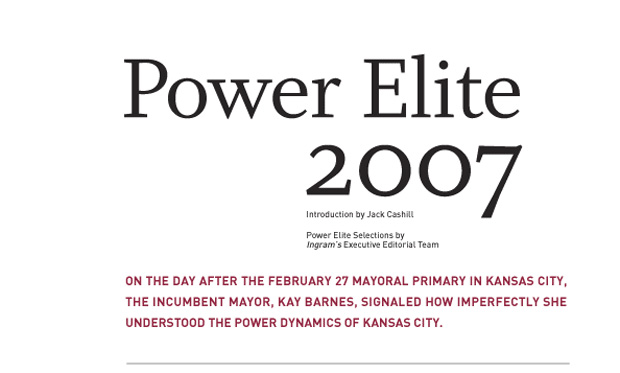On that day, she sent an urgent communication to twenty-three people that she judged to be among the most influential in Kansas City. Among them were several who find themselves in the top ten of Ingram’s power elite—Bill Zollars of YRC, Tom McDonnell of DST, and Terry Dunn of J.E. Dunn—as well as any number of others who grace our list or who have graced it in the past.
The source of Barnes’ worry was the surprisingly strong showing of former auditor Mark Funkhouser in the primary. She invited the group to an emergency breakfast the very next day to share her anxiety about “the Funk” and his potential effect on the city.
“I am concerned,” the mayor wrote, “that the progress we have achieved, in large part because
of your efforts, are [sic] now in jeopardy.”
Mayor Barnes also promised that Funkhouser’s opponent, city councilman Alvin Brooks, would be on hand to answer any questions that the group might have. In the process of designating Brooks as her chosen successor, however, Barnes may very well have doomed his candidacy.
As we have argued before, there are two primary variables in the calculus of power in any American city: weight on the one hand; and the willingness and ability to throw it on the other, weight being the more important variable. As a way to visualize this conceit, imagine the power equation as P = 2W x T. Power = Twice Weight x Throw.
Although no one could doubt the mayor’s throw, she and her advisors, however, seriously overestimated her weight. Many of those with whom she communicated were much more powerful than any mayor. They were not particularly anxious about the transition and were not about to be swayed by her appeal. Downtown Kansas City’s most significant landlord, DST CEO Tom McDonnell, was among those who would publicly back Funkhouser.
Nor did Barnes’ appeal play well with the voters who had yet to decide. The narrowness of Funkhouser’s winning margin—just a little more than one percent citywide—conceals a certain imbalance in those votes. Funkhouser, for instance, received less than 10 percent of the vote in six of the city’s twenty-six wards, all on the east side.
To win the election, Funkhouser needed to capture at least two-thirds of the vote in the city’s predominantly white neighborhoods. North of the river, Funkhouser took 72 percent of the vote. This is where Barnes lives. This is the base that Barnes supporters believe will launch her successful challenge to Sam Graves’ seat in Congress in 2008. As the vote suggests, however, this is not reliable Barnes’ territory.
Alvin Brooks is well liked and respected in the corridor up and down state line. Early in the campaign, his yard signs dominated Ward Parkway. The support for Brooks ebbed as voters, rightly or wrongly, came to see him not as his own man, but as Barnes’ proxy.
In the city’s most influential ward, the one just south of the Country Club Plaza, Funkhouser did better than he did in any ward of the city, securing 73 percent of the vote. This vote represented not a knee-jerk reaction against tax increment financing, but a studied rejection of the arbitrary dispensation of perks and power at City Hall.
The impending shift in power at City Hall has little impact on those high on Ingram’s power elite list. It will, however, diminish the clout of many of those further down the list, particularly the city manager and advisors, including several development lawyers who had the mayor’s ear, not to mention a hefty share of her $2 million annual budget for such advisors.
To make the list more interesting from one year to the next, we have chosen—not without a fair amount of internal dissent—to rank this year’s Power Elite. We understand better than anyone the difficulty of arranging the apples of corporate power, the oranges of civic power, and the peaches of philanthropic power in one hierarchy.
To be sure, there has been some disagreement among us on the ranking, but we are all reasonably comfortable with the final outcome.
Although we at Ingram’s typically speak to a 20-county greater Kansas City metro area, we generally observe an eight-county core in the Power Elite ranking. The political figures on the list we judged
by their impact not on the world, but on our world.
If your name is not on the list, and you think it should be, sorry, but you were 51st and just missed the cut. Your comments are welcome. We would, however, prefer e-mails that begin, “Next year, you might include,” over those that begin, “How dare you!” Going forward, we intend to make this list as authoritative as possible and we want your input.
We apologize in advance to those who had hoped to see a Power Elite that “looks like civic Kansas City.” This one doesn't.
To amend the list to make it look more like we might want it to, however, would only undermine the achievements of everyone who did make the list. We would recommend that those concerned with diversity, or the lack of it, address those concerns to the power structure itself, not those who analyze it.
By the by, it should be noted that of the twenty-three individuals who received invitations to Mayor Barnes’ power breakfast, twenty-three were men. Of the twenty-three men, twenty-two were white.
«April 2007 Edition
